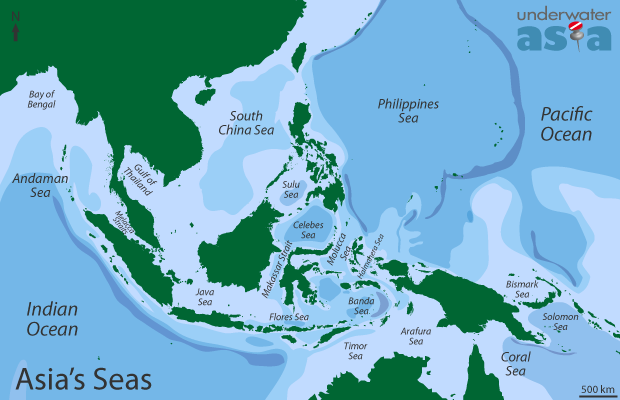
Asia is caught between two huge oceans, the Indian Ocean to the west and the Pacific to the east. In between is a complex geography of land & water that has given rise to some of the most fascinating & species rich seas on our planet.
Much of the geography of south-east Asia is dictated by the Pacific Ring of Fire, a geologically active zone around the edges of the Pacific, that encompasses the region and shapes the landscape producing volcanoes, mountains, island chains & trenches.
This complex geography has also produced 15 unique seas and many straits, which between them comprise the most complex & diverse eco-system on the planet.
From ocean to ocean
Starting to the west, the Andaman Sea sits between the Indian Ocean & the coasts of Burma, Thailand, Malaysia & Indonesia, drifting into the Bay of Bengal in the north. Its western perimeter is marked by the remote Andaman Island chain. The Similans, Mergui Archipelago & Pulah Weh are some of the great diving spots in the Andaman.
Thailand, Peninsular Malaysia & the giant Indonesian island of Sumatra separate the Andaman Sea from the South China Sea, the largest in Asia. This sea stretches across to the Philippines in the east, laps the shores of Borneo to the south, and Vietnam & China to the north.
The South China Sea comes to a head in the shallow Gulf of Thailand. This is one of the few parts of Asia where the flow of water is slow, meaning the water is not as rich in nutrients as other seas in the region.
To the east, the sea increases in depth as it reaches the Philippines, giving rise to some spectacular dive spots, such as Layang Layang & the sites of northern Palawan.
Separated from the South China Sea by the island of Palawan is the Sulu Sea. The Sulu Sea is one of the smallest, but most productive of Asia’s seas. The Sulu Sea marks the northern tip of the now famous Coral Triangle, the most biologically diverse marine region on earth. It reaches northern Borneo to the south and the islands of the Visayas & Mandanao in the Philippines to the east.
The Sulu Sea is deep, bringing nutrient rich upwellings from great depths that support the spectacular congregations of marine life found at sites such as Sipadan & the remote Tubbataha Reefs. The popular dive sites of the Visayas region also fall within the Sulu Sea.
To the east, the Philippines Sea reaches out to the Pacific Ocean. Here, where the Pacific techtonic plate disappears below the Philippine plate, the sea plunges to the greatest depths on the planet. This trench is known as the Mariana trench, reaching a staggering depth of 10.9 km.


Tara North

Phil North
You might also enjoy...
Underwater housing care
Jakob Owens
Buying all the kit to allow you to take photos underwater is not cheap, so you need to make your equipment lasts the test of time.
One of the major and most vital expenses is your underwater housing. Housings are often fragile and can require a lot of care and attention though. So what should you be doing to look after your housing and to make sure it has a happy and healthy life?
Fish identification
Christian Gloor
For many divers the thrill of spotting and identifying a new fish is one of the reasons they love to dive.
But identifying a new fish is never that easy, especially considering the sheer abundance of different species that make their home in Asia's incredible reefs.
So we've put together some tips to help you to improve your identification skills and get more out of your diving.
Get Involved
Brian Yurastis
Like many people, especially those who dive & love the oceans, you are no doubt concerned by the plight of our oceans and worried what the future may hold. The marine world needs our help, but sometimes it is easy to feel like you can't make a difference.
Dummie's guide to camera kit
Jakob Owens
Do you struggle to know your arm from your socket, your port from your bracket, your flash from your fisheye and your light from your lens?
Well, you're not alone. Underwater photography has it's own dictionary of parts, accessories & technical terms and it's tough to sound like an expert.
The triangle of life
The underwater world of South-East Asia has long been famed for its wealth & diversity of marine life. But it is only relatively recently that scientists have begun to get a hold on just how diverse and special the area is.
Choosing the right dive spot
Phil North







